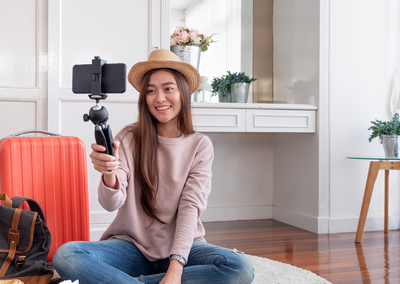 Open up your Instagram app and tap the magnifying glass to look through popular posts. Chances are, you're going to find a few sponsored posts from influencers. This means that these Instagram users have partnered with companies to promote their product or service, either for a fee or in exchange for free products or services.
Open up your Instagram app and tap the magnifying glass to look through popular posts. Chances are, you're going to find a few sponsored posts from influencers. This means that these Instagram users have partnered with companies to promote their product or service, either for a fee or in exchange for free products or services.
These companies are smart to do this because many Gen Y and Gen Zers resonate more with products and services that they see their peers using. This is called influencer marketing, and it can be a great strategy to use for your business.
Here's how to get started with influencer marketing in your business.
1. Define your digital marketing goals.
In order to determine if your company will be successful with influencer marketing, you need to take a look at your overall digital marketing goals and budget. If you don't have enough budget to pay out your influencers, putting any effort in influencer marketing is a waste of time.
However, if you're trying to reach a younger audience, build a larger audience on Instagram, and have more user-generated content to incorporate into your strategy, influencer marketing might be a great idea.
2. Create a target influencer profile.
You don't want to reach out to a dozen influencers to create partnerships if their followers aren't actually going to be the least bit interested in your product or service. Instead, you need to sit down with your marketing team or agency to build an influencer profile based on the interests of your target audience.
What do you need to look for in an influencer?
- They're active on social media.
- They have a large audience.
- They have an engaged audience (i.e., a good percentage of their followers actually comment and like their photos).
- They're authentic.
- Their content resonates with your brand.
Your target influencers should look a lot like your target audience because it's likely people are following bloggers and influencers to whom they relate. If you're reaching out to influencers who don't look anything like the type of people who would buy your product or service, you're not going to have any success.
3. Find your influencers.
This is the tricky part: actually finding the perfect influencers to work with your brand. Where do you even start looking, and how do you reach out to them?
First, take a look around social media. This makes it easier to take a look at their current content and followers to see if they fit well within your brand. Search for hashtags relevant to your audience and be sure to follow several so that you can keep up with them for a while before deciding whether you should reach out or not.
Here are a few other ways to find your influencers:
- Do a Google search. Look for bloggers and experts within your industry that have a voice within your demographic. Read blog posts, conduct searches for influencers in your niche, and do plenty of research before deciding on your influencers.
- Use an influencer marketplace. Sites like TapInfluence were created for this exact purpose in mind: connecting businesses with influencers who can help promote their products or services. Look for a couple of good influencer marketplaces to check out and see if you can find any experts in your industry.
- Set up social media monitoring. We already covered using social media to search for your influencers. For long-term influencer research, set up social media monitoring tools to keep an eye out for certain keywords that influencers in your industry likely use. Search for conversations surrounding your business and your industry to find people who are already talking about your product or service and see if you can get them talking about your specific company.
 4. "Stalk" potential influencers.
4. "Stalk" potential influencers.
We mean social media stalking, not stalking in the literal sense. Check out their entire social media profile. Read their captions. Look at the comments on their posts. Look at how many likes each of their posts gets. Click all of the links in their profile to see where they lead. Check out the types of accounts they're following. Take notes on how often they promote brands, and who those brands are.
No, it's not creepy. You're vetting potential faces for your brand on social media. You want to make sure they're going to represent you well. Doing thorough research on their social media profile can help confirm whether or not they're a good match for you. Then you can reach out.
5. Get in touch with your potential influencers.
Some influencers make it easy to reach out to them for any potential brand partnerships. Others are a little bit harder to reach. Start with the ones who lay it out plainly with something like a PR/marketing page on their blog/website with a clearly outlined media kit and contact form or email address.
Then move on to the influencers that you would love to work with but who may be a bit tougher to find.
Start by introducing yourself. Let them know who you are, what business you're with, and why you're contacting them. Chances are, they'll be happy to hear from you and will have no problem getting right back in touch with you. Then you can discuss rates, product/service exchanges, and more before deciding whether or not to work together.
Influencer marketing can be an incredibly powerful tool for your business, especially if you're marketing to the younger generations. Partnering with real people on social media over celebrities helps create a peer relationship with the influencers and their followers. Their followers are seeing real, actual people using your company's products/services, and it's going to make them that much more likely to be interested in your business themselves.
To learn more about influencer marketing and other digital marketing strategies that could help grow your business, contact us today.
No comments:
Post a Comment